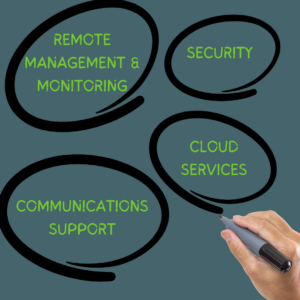 In today’s tech-driven world, Managed IT Services play the role of a trusted helper for businesses, offering them a wide range of remote solutions. Whether it’s fixing a sudden problem or keeping an eye on things during the day and night, the services we offer are supposed to make your life easier. Not only do they help lighten the load for in-house IT teams, but they also fill the gaps in terms of resources.
In today’s tech-driven world, Managed IT Services play the role of a trusted helper for businesses, offering them a wide range of remote solutions. Whether it’s fixing a sudden problem or keeping an eye on things during the day and night, the services we offer are supposed to make your life easier. Not only do they help lighten the load for in-house IT teams, but they also fill the gaps in terms of resources.
So when picking a managed IT service provider, make sure they know what they are doing; after all, it’s not just bits and bytes; it’s your business setup that you need protection for,
What is a Managed IT Service?
Managed IT Service is a way of partial and complete outsourcing of maintenance, implementation, migration, and the upgrade of the IT infrastructure. This also includes outsourcing security and backup to a third-party vendor from a different location or conducting remote operations. The solutions are offered by IT services that manage to take care of you, and the company providing these services is known as a managed service provider.
Common Services Used by Our Managed IT
Managed IT services revolve around the following key tasks to ensure your technology is running efficiently:
- Remote management and monitoring: This allows our team of professionals to keep an eye on your servers, computers, and different hardware devices from a distance. It helps identify minor issues that could lead to more significant problems and cause challenges in the workflow.
- Security: Security services include watching out for potential dangers such as hackers, testing the system to highlight weak spots, and responding with a stronger comeback in case of a cyber attack. It’s similar to having a bodyguard, but this one is digital and ensures your data isn’t compromised.
- Cloud services and their management involve setting up and then looking after your software and online storage. Whether it’s the process of running different programs, storing multiple files, or having a properly managed IT service, make sure everything is streamlined and goes exactly as planned.
- Communications support: This includes assisting with internet-based phones and making sure all your calls are smooth. It’s similar to a tech-savvy assistant handling all your calls.
The Evolution of Managed IT Services
The progression of managed IT services over the years:
- Break-fix Model – Stage 1: IT services and management were provided based on breaks and fixes in the initial stages. A technician would only view managed computer systems when they had trouble functioning. Usually, the IT specialist is the same person who deploys the network or the computer systems.
- The rise of large manufacturers – stage 2: This is when the system began to expand until industry giants like Microsoft, IBM, and Apple dominated them. This is when small IT dealers had to give less time to the production side and more to the break-fix aspect of things. The approach towards maintenance was more active, time-consuming, expensive, and labor-intensive. It gave the IT technicians flexibility to expand their business and even get ahold of new customers.
- An increase in the demand for managed service – Stage 3: At the same time, the number of computers increased significantly yearly. The difference between the number of machines and the specialists increased effectively. Due to this need, the evolution of managed IT services increased in the 2000s, as multiple third-party companies started specializing in IT services with the capacity to deliver bulk services.
- Efficiency becomes viral – stage 4: A new approach led to a routine with proactive servicing, software updates, system monitoring, and troubleshooting, which prevented the occurrence of problems. Cloud computing and automation services enabled issues to get resolved instantly and remote management over the next few years. This led to operations becoming more effective and resources being streamlined.
- Managed IT services tools and upgrades – stage 5: MSPs have come a long way since they began. Nowadays, these experts have various IT skills and tricks to fix multiple problems quickly. For instance, there’s special software called professional services automation that helps MSPs organize their work. They also use multiple tools to provide IT services all day, every day. With these tools, client information remains safe, and MSPs can lower the cost for clients, allowing them to receive better service.
The Benefits of Managed IT Services
There are various benefits that companies can gain from managed IT service providers:
Efficient Services
Outsourcing various IT tasks to managed services can allow your teams to focus on essential tasks such as generating revenue. These experts ensure people have guidance and recommendations to help them optimize the performance of their IT infrastructure. This can also lead to a better ROI and increase productivity.
Improving Uptime Performance
The managed IT service provider team doesn’t work on the same clock as other employees. IT providers can efficiently conduct system updates and even maintenance during off-hours. When MSPs have a flexible schedule that revolves around your timings, you see an increased uptime and fewer workflow disruptions.
Setting Terms Under Contract
Managed IT services allow you to set terms under a contract to conduct IT tasks that include service-level agreements. This means you don’t have to work on recruiting and training IT staff. You need to pay only for the coverage or the services you require and avoid any costs that come with the maintenance of a full-time employee.
3 Steps to Taking Effective Decisions About IT MSPs
When choosing an IT-managed service provider, there are some things you must follow as per protocol to ensure that what you choose fits your requirements. Although these steps need added effort, an assessment of what you need, assets, and goals will help you promise you will get the most from any providers you choose.
Assessing Contemporary IT Systems
Before hiring an MSP, evaluating your current IT expenses and needs is essential. This means you need to figure out what areas of your technological setup and workflows you want the MSP to handle, what tools you require, and what your current resources are. Another important thing is how much you wish to spend to manage everything and the goal of the business.
For instance, if you need additional help for your IT team, you will look for a different MSP than if you want a whole team to take care of all matters. Also, consider your company and whether outsourcing IT management would be better for your company in the long term or building an in-house team. Even though outsourcing might be cheaper at first, eventually, when your business grows, it could be best if you have your team in place.
Request an Audit
After you have shortlisted all the potential service providers, beginning with a system audit is best. This audit assists you in figuring out if they’re capable and experienced in handling your company assets.
It’s essential to check if the providers are trained with the different software you use or plan to use and the hardware. Also, make sure they know about the rules of the industry and the standards that affect your data and systems. If they have trouble with proper auditing, they’ll unlikely be able to support your systems properly.
Consider Flexibility
When looking at different sellers, think about their services and how well they can grow along with your needs. Good IT service providers should be able to handle more workloads, offer more help, and have more skills than you need. If they struggle to keep up, they might slow you down instead of helping you.
This is important if you’re considering massive changes to your organization, like moving towards the cloud. You might want a provider that can handle your company’s growth without leaving any gaps in the service and causing issues.
How Ashton Solutions Helps in Improving Managed IT Services
MSPs often need to deliver affordable, scalable capacity availability. To meet these requirements, MSPs must provide smooth integration without wasting multiple resources on support. To help MSPs meet the requirements, Ashton Solutions provides two types of services:
- Managed and Co-managed IT: We take care of all your IT needs and work alongside your existing IT team to assist with troubleshooting, maintenance, extra support, and expertise.
- Security: We implement strong security measures to protect your data and the systems from cyber threats.
- Network Infrastructure: We design and maintain a trusted network system to keep your business interconnected.
- Cloud Migration: We assist you with the transitions to cloud-based systems for added scalability and flexibility.
- Wireless Networks: We set up and manage a wireless network for smooth connectivity across your company.
- Compliance: We ensure your IT system complies with the regulations and standards set by the industry.
- Security Training: We provide training to your team and educate them on the best practices for cybersecurity.
- IT and Security Audits: We conduct thorough IT audits to identify security and IT infrastructure weaknesses.
Ashton Solutions is ideal for your managed IT services because we offer detailed solutions catering to your needs. With our expertise and dedicated service, you can trust us to keep your business running smoothly and efficiently.





